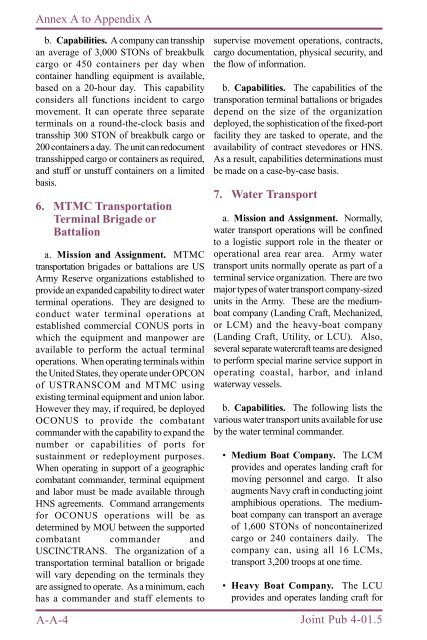JP 4-01.5 JTTP for Water Terminal Operations - BITS
JP 4-01.5 JTTP for Water Terminal Operations - BITS
JP 4-01.5 JTTP for Water Terminal Operations - BITS
You also want an ePaper? Increase the reach of your titles
YUMPU automatically turns print PDFs into web optimized ePapers that Google loves.
Annex A to Appendix A<br />
b. Capabilities. A company can transship<br />
an average of 3,000 STONs of breakbulk<br />
cargo or 450 containers per day when<br />
container handling equipment is available,<br />
based on a 20-hour day. This capability<br />
considers all functions incident to cargo<br />
movement. It can operate three separate<br />
terminals on a round-the-clock basis and<br />
transship 300 STON of breakbulk cargo or<br />
200 containers a day. The unit can redocument<br />
transshipped cargo or containers as required,<br />
and stuff or unstuff containers on a limited<br />
basis.<br />
6. MTMC Transportation<br />
<strong>Terminal</strong> Brigade or<br />
Battalion<br />
a. Mission and Assignment. MTMC<br />
transportation brigades or battalions are US<br />
Army Reserve organizations established to<br />
provide an expanded capability to direct water<br />
terminal operations. They are designed to<br />
conduct water terminal operations at<br />
established commercial CONUS ports in<br />
which the equipment and manpower are<br />
available to per<strong>for</strong>m the actual terminal<br />
operations. When operating terminals within<br />
the United States, they operate under OPCON<br />
of USTRANSCOM and MTMC using<br />
existing terminal equipment and union labor.<br />
However they may, if required, be deployed<br />
OCONUS to provide the combatant<br />
commander with the capability to expand the<br />
number or capabilities of ports <strong>for</strong><br />
sustainment or redeployment purposes.<br />
When operating in support of a geographic<br />
combatant commander, terminal equipment<br />
and labor must be made available through<br />
HNS agreements. Command arrangements<br />
<strong>for</strong> OCONUS operations will be as<br />
determined by MOU between the supported<br />
combatant commander and<br />
USCINCTRANS. The organization of a<br />
transportation terminal batallion or brigade<br />
will vary depending on the terminals they<br />
are assigned to operate. As a minimum, each<br />
has a commander and staff elements to<br />
A-A-4<br />
supervise movement operations, contracts,<br />
cargo documentation, physical security, and<br />
the flow of in<strong>for</strong>mation.<br />
b. Capabilities. The capabilities of the<br />
transporation terminal battalions or brigades<br />
depend on the size of the organization<br />
deployed, the sophistication of the fixed-port<br />
facility they are tasked to operate, and the<br />
availability of contract stevedores or HNS.<br />
As a result, capabilities determinations must<br />
be made on a case-by-case basis.<br />
7. <strong>Water</strong> Transport<br />
a. Mission and Assignment. Normally,<br />
water transport operations will be confined<br />
to a logistic support role in the theater or<br />
operational area rear area. Army water<br />
transport units normally operate as part of a<br />
terminal service organization. There are two<br />
major types of water transport company-sized<br />
units in the Army. These are the mediumboat<br />
company (Landing Craft, Mechanized,<br />
or LCM) and the heavy-boat company<br />
(Landing Craft, Utility, or LCU). Also,<br />
several separate watercraft teams are designed<br />
to per<strong>for</strong>m special marine service support in<br />
operating coastal, harbor, and inland<br />
waterway vessels.<br />
b. Capabilities. The following lists the<br />
various water transport units available <strong>for</strong> use<br />
by the water terminal commander.<br />
• Medium Boat Company. The LCM<br />
provides and operates landing craft <strong>for</strong><br />
moving personnel and cargo. It also<br />
augments Navy craft in conducting joint<br />
amphibious operations. The mediumboat<br />
company can transport an average<br />
of 1,600 STONs of noncontainerized<br />
cargo or 240 containers daily. The<br />
company can, using all 16 LCMs,<br />
transport 3,200 troops at one time.<br />
• Heavy Boat Company. The LCU<br />
provides and operates landing craft <strong>for</strong><br />
Joint Pub 4-<strong>01.5</strong>
















